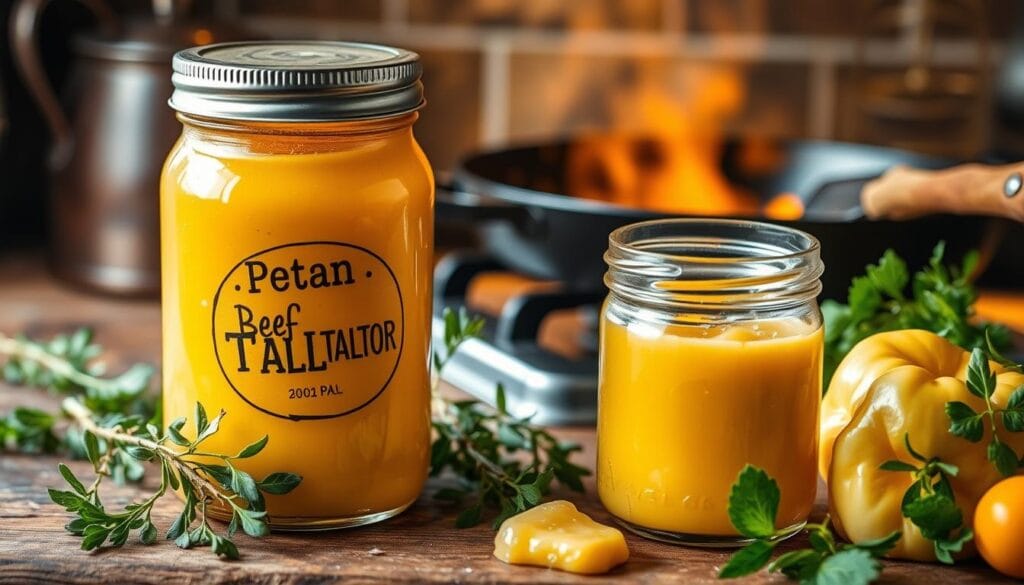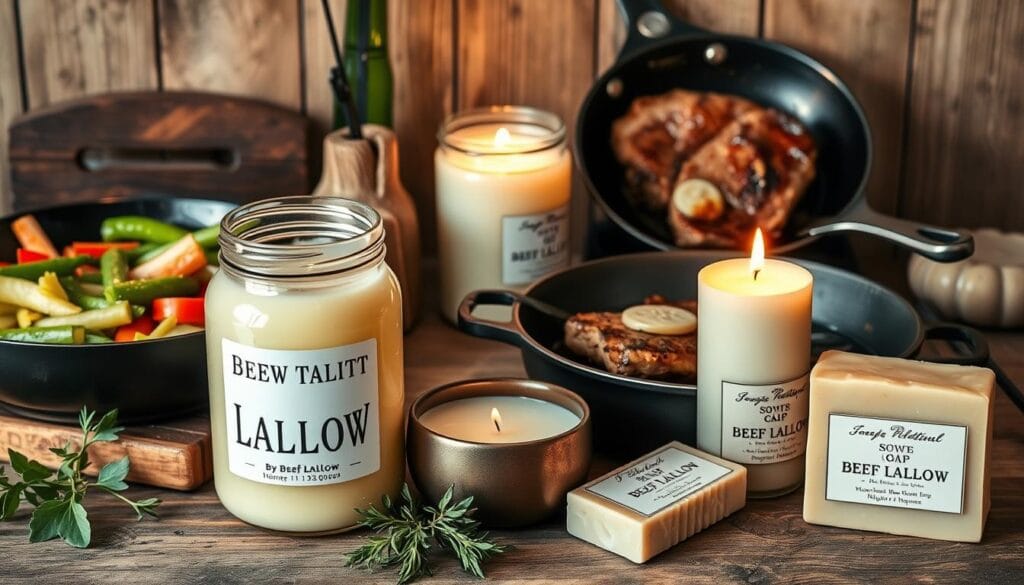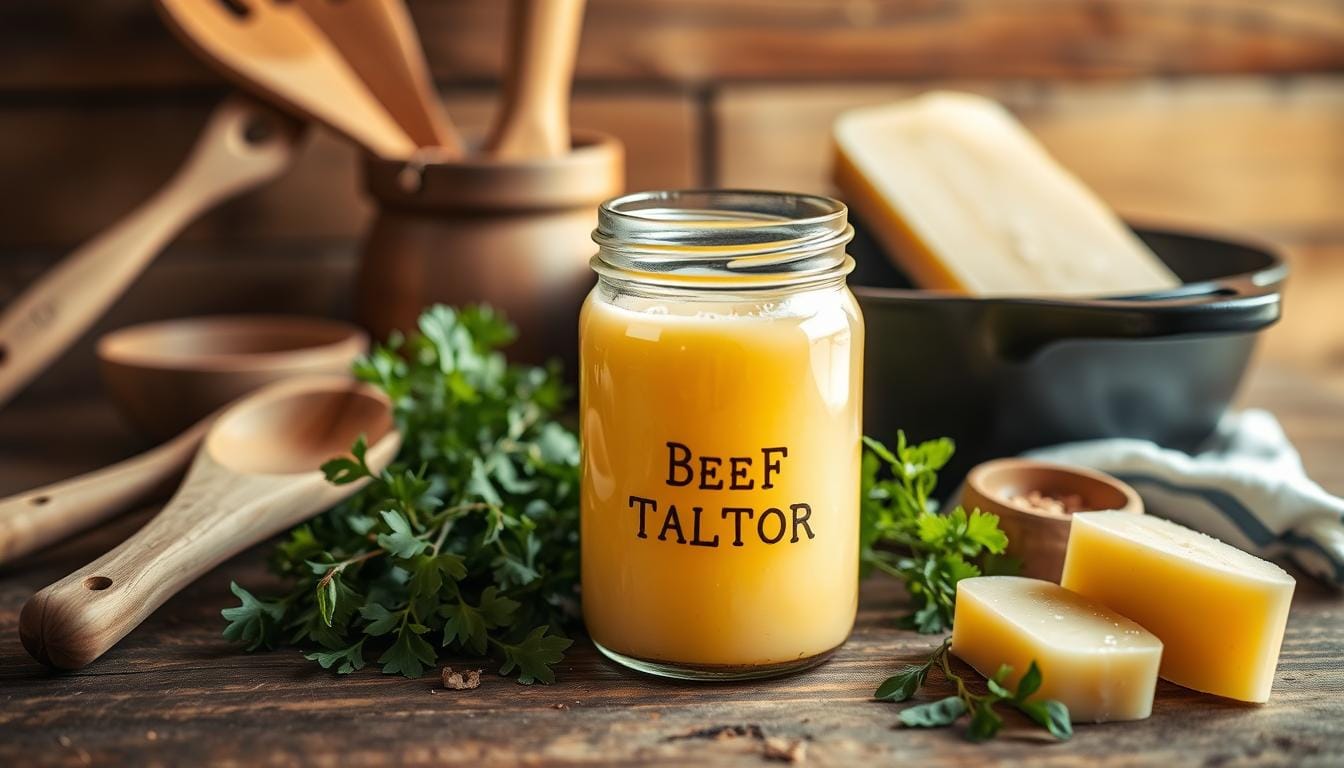As an Aussie home cook, I’ve always been drawn to traditional cooking fats. Vegetable oils are common today, but beef tallow’s deep flavour and unique qualities are hard to resist. It’s making a comeback, and for good reasons.
Beef tallow is a solid white fat made from cattle fat. It was once a key part of Australian cooking. Now, it’s back in kitchens for its health benefits and rich taste.
Table of Contents
Key Takeaways
- Beef tallow is a versatile cooking fat with a high smoke point, making it ideal for high-heat cooking methods.
- Tallow contains beneficial fatty acids, including conjugated linoleic acid (CLA), and essential fat-soluble vitamins.
- Sourcing grass-fed beef tallow can enhance the nutrient profile and sustainable attributes of this traditional fat.
- Beef tallow has applications beyond the kitchen, such as in skincare and personal care products.
- Proper storage and handling can extend the shelf life of this natural cooking fat.
Understanding Beef Tallow: From Traditional to Modern Usage
Beef tallow is a fat made from beef suet or dripping. It’s been a key part of Australian kitchens for ages. Unlike other fats, tallow is solid at room temperature and rich in saturated fats. For years, it was prized for its flavour and long shelf life.
What Makes Tallow Different from Other Fats
Tallow is 100% fat, with lots of monounsaturated and saturated fatty acids. This mix makes it perfect for high-heat cooking, like frying and searing. Its high smoke point is 249°C (480°F).
Historical Significance in Cooking
Beef tallow has been around for thousands of years. Ancient Egyptians and Mesopotamians used it a lot. By the 13th century, candle makers were big in Europe, thanks to tallow candles.
Modern Renaissance in Kitchens
During the Industrial Revolution, tallow lost favour to cheaper vegetable oils. But now, chefs and home cooks are loving it again. Its health benefits and kitchen versatility have sparked a comeback.
Byron Bay Tallow is a top pick for health lovers. It’s made from grass-fed beef and has a rich flavour. It’s also good for the planet, supporting ethical farming.
The Production Process of Pure Beef Tallow
Beef tallow is a healthy cooking fat made through careful rendering. This method heats beef fat, or suet, to separate the pure tallow from other parts. Byron Bay Tallow uses grass-fed, free-range beef from ethical farms in Australia.
The rendering process is a detailed task. It heats the fat gently to remove impurities. This way, it keeps the important vitamins, minerals, and fatty acids. This method makes a clean, pure tallow with great taste and health benefits.
Unlike common tallow, Byron Bay Tallow is made from high-quality sources. It’s a true quality product. It improves your cooking and supports sustainable farming, making it a good choice for health-aware Australians.
“Beef tallow is a versatile and nutritious cooking fat that has been used for centuries. Our handcrafted tallow is a true celebration of quality, sustainability, and the rich tradition of Australian cuisine.”
By choosing top-quality, grass-fed beef and a careful rendering process, Byron Bay Tallow avoids harmful pollutants. Their tallow is pure and healthy. It’s perfect for cooking, adding flavour and nutrients to your meals.
Nutritional Profile and Health Benefits of Beef Tallow
Beef tallow is a nutrient-dense fat made from rendered beef fat. It has a rich nutritional profile and many health benefits. This wholesome fat is great for cooking and is good for you.
Essential Fat-Soluble Vitamins
Beef tallow is packed with vitamins A, D, E, and K. These vitamins are important for your immune system, bones, and cells. Eating grass-fed beef fat with tallow helps your body absorb these vitamins better.
Beneficial Fatty Acid Composition
Beef tallow has a mix of different fats. It has saturated, monounsaturated, and polyunsaturated fats. It’s especially rich in stearic acid, a fat that might not increase cholesterol like other saturated fats. It also has oleic acid and conjugated linoleic acid (CLA), which are good for you.
Conjugated Linoleic Acid (CLA) Content
Beef tallow is a natural source of conjugated linoleic acid (CLA). CLA might help with body fat, improve body composition, and have anti-inflammatory effects. Adding grass-fed beef fat to your diet can be beneficial.
“Tallow from grass-fed cattle often provides a more nutrient-dense profile compared to conventional sources, making it a wholesome fat choice for culinary and health-conscious consumers.”
High Smoke Point and Cooking Applications
Beef tallow has a high smoke point of about 400°F (204°C). This makes it great for high-heat cooking like frying, sautéing, and roasting. It stays stable and doesn’t burn easily, which means less harmful free radicals are formed.
Beef tallow is not just for high heat. It’s also good for spreading, baking, and general cooking. Its rich flavour can make dishes taste better, adding depth that other fats can’t.
Beef tallow is perfect for searing meats, getting that nice caramelized crust. It’s also great for roasting potatoes, making them crispy on the outside and fluffy inside. Plus, it’s used in making roux for sauces and gravies, adding a luxurious feel and flavour.
In barbecue, beef tallow makes meats like brisket taste amazing. Wrapping them in tallow-infused paper or foil makes the meat tender and flavourful. It’s also good for keeping cast-iron cookware seasoned, adding flavour and making it non-stick.
| Cooking Fat | Smoke Point | Suitable for High-Heat Cooking |
|---|---|---|
| Beef Tallow | 400°F (204°C) | Yes |
| Olive Oil | 375°F (190°C) | No |
| Coconut Oil | 350°F (177°C) | No |
| Butter | 300°F (149°C) | No |
| Ghee | 485°F (252°C) | Yes |
Beef tallow is great for many cooking tasks, from frying to baking. Its high smoke point, rich flavour, and health benefits make it a top choice. It’s a must-have in any kitchen.

Grass-Fed vs Conventional Beef Tallow
Beef tallow’s nutritional value and sustainability depend on its source. Grass-fed beef tallow is often better than conventional because it’s more nutritious and has good fats.
Nutrient Density Comparison
Grass-fed tallow is packed with vitamins A, D, E, and K. It also has a good balance of omega-3 to omega-6 fatty acids. Research shows it has less inflammatory omega-6 and more omega-3 than grain-fed tallow. It also has more beneficial CLA, which is good for health.
Sustainable Farming Practices
Grass-fed beef tallow comes from farms that care about animals and the environment. Cattle eat grass, live naturally, and are better for the soil and air. This makes grass-fed tallow a greener choice.
| Nutrient | Grass-Fed Tallow | Conventional Tallow |
|---|---|---|
| Omega-3 Fatty Acids | Higher | Lower |
| Omega-6 Fatty Acids | Lower | Higher |
| Conjugated Linoleic Acid (CLA) | Higher | Lower |
| Saturated Fatty Acids | Higher | Lower |
| Monounsaturated Fatty Acids | Higher | Lower |
| Polyunsaturated Fatty Acids | Lower | Higher |
Choosing between grass-fed and conventional beef tallow is about nutrition and ethics. Grass-fed tallow is better for those who want a healthier, more sustainable choice.
Versatile Uses Beyond the Kitchen
Beef tallow is more than just a kitchen staple. It’s now a hit in skincare because it’s like our skin oils. It deeply moisturises and makes skin more elastic, making it a top pick for moisturisers and serums.
But that’s not all. Beef tallowine is also in artisanal soaps, candles, and leather conditioners. Its anti-inflammatory effects and fat-soluble vitamins help with skin issues like eczema.
Back in the day, tallow was used for everything from oiling machines to feeding pets. Now, it’s back in favour, showing its lasting value and uses beyond cooking.
- Skincare: Tallow’s similarity to human skin oils makes it a potent moisturiser and enhancer of skin elasticity.
- Soap and Candle Making: Tallow’s slow-burning properties and clean-burning profile make it ideal for producing long-lasting, sustainable candles and nourishing soap bars.
- Leather Conditioning: Tallow’s natural conditioning properties make it a valuable ally in restoring and protecting leather goods.
- Eco-Friendly Alternatives: Tallow can be molded into reusable containers or wraps, providing a biodegradable alternative to plastic.
- Haircare: Tallow can be used as a natural hair mask to nourish and moisturise dry, damaged tresses.
- Fire Starters: Tallow’s long-lasting burn properties make it an excellent choice for DIY fire starters, ideal for camping or emergency situations.
- Skin Healing: Tallow’s anti-inflammatory properties and fat-soluble vitamins make it suitable for healing skin issues like cuts, burns, and rashes.
- Pet Care: Tallow can be used to condition pets’ paws and added to their food for healthy fats.
From skincare to household uses, beef tallowine and natural animal fat are winning hearts. They show the timeless worth of this traditional, sustainable resource.

Storage and Shelf Life Considerations
Storing rendered beef fat, or natural animal fat, right is key. It keeps the fat fresh and good for cooking for a year or more. This makes it a great, long-lasting item for your kitchen.
Proper Storage Methods
For the best storage, keep beef tallow in an airtight container in a cool, dark spot. Think a pantry or cupboard. If you refrigerate it, it can stay fresh for up to a year. Freezing it can keep it good for over two years.
Signs of Spoilage
Watch for color changes, bad smells, or mold to spot spoiled rendered beef fat. Good tallow is pale and smells like meat. Any weird smells or colors mean it’s gone bad and should be thrown away.
By storing it right and checking for spoilage, your natural animal fat stays a trusted cooking fat. It will help make your dishes better for months.
Traditional Cooking Methods with Beef Tallow
Beef tallow has been a key part of Australian cooking for years. It’s loved for its versatility and rich taste. This natural fat has been used in many cooking ways for generations, linking today’s kitchens with the past.
Beef tallow is great for deep frying. It can get up to 420°F (215°C), making foods like potatoes and doughnuts crispy and golden. It also keeps the frying temperature steady, making dishes taste better.
It’s also good for searing meats. It creates a tasty crust and keeps the meat juicy. This method makes the meat tender and full of flavour.
- Beef tallow’s high smoke point makes it ideal for high-heat cooking methods like deep frying, searing, and roasting.
- In baking, tallow can be used as a substitute for butter or shortening, particularly in savoury pastries and pie crusts, adding a unique richness and flakiness.
- Traditional dishes like roasted potatoes cooked in beef dripping showcase the distinctive flavour profile that tallow can impart to cuisine.
Using beef tallow in these old cooking ways connects today’s kitchens with the past. It shows how versatile and useful this traditional cooking fat and natural cooking fat is.
“Beef tallow has been a staple in traditional cooking methods for generations, and its unique properties make it an indispensable tool in the modern Australian kitchen.”
Sustainability and Ethical Considerations
Choosing the right fats and oils is key in cooking and nutrition. Using grass-fed beef fat supports nose-to-tail eating. This method reduces food waste by using every part of the animal. It also promotes sustainable and ethical farming.
Choosing grass-fed beef tallow from ethical Australian farms helps the environment. It supports regenerative agriculture, which improves soil health and biodiversity. Making tallow from meat processing is more sustainable than some vegetable oil production methods.
- The U.S. market for rendering and meat byproduct processing is valued at $7.3 billion, indicating the significant role of animal fats in the food industry.
- Around 99 percent of livestock in the U.S. are raised on factory farms, highlighting the need for more sustainable and ethical farming practices.
- Tyson Foods, one of the leading meat producers, has been responsible for discharging 371 million pounds of pollutants into U.S. waterways between 2018 and 2022, demonstrating the environmental impact of conventional meat production.
Grass-fed beef production is better for the environment. It leads to less waste and uses fewer chemicals. It also helps sequester carbon in the soil.
Choosing grass-fed beef tallow supports local farmers. It also helps the community and local economies. This reduces the power of big agribusiness in meat production.
“Grass-fed beef has about two to four times higher omega-3 fatty acid content compared to grain-fed beef, making it beneficial for reducing inflammation and promoting heart health.”
Using grass-fed beef fat in your cooking helps a sustainable food system. It also brings rich flavour and health benefits to your dishes.
Common Misconceptions About Animal Fats
Animal fats like wholesome fat from beef tallow face many misconceptions. The old idea that natural animal fat raises heart disease risk is being questioned. It’s time to clear up these myths and understand animal fats better.
Debunking Saturated Fat Myths
New studies show the link between saturated fat and heart disease is more complex. Stearic acid, found in natural animal fat like beef tallow, might not be bad for cholesterol. This contradicts the idea that all saturated fats harm heart health.
Understanding Modern Research
Recent research paints a more detailed picture of wholesome fat and health. A 2020 study in the Journal of the American College of Cardiology found no link between unprocessed red meat and heart disease. It also showed that in some Asian countries, eating red meat might lower disease risk.
By understanding these findings, we can better use wholesome fat like beef tallow in our diets. It’s key to clear up myths and adopt a holistic health approach.
Conclusion
Beef tallow is making a comeback in Australian kitchens. It’s packed with nutrients and can be used in many ways. This makes it a great choice for those looking for healthier fats.
While more studies are needed, early signs are promising. Tallow has been used for ages and recent studies back its health benefits. It could be a good part of a healthy diet.
Choosing beef tallow means going back to simpler, whole foods. It’s part of a bigger trend towards healthier eating in Australia. This natural fat is a great option for those who care about their health.
Beef tallow is versatile and could be very beneficial for Australian cooking. As more research is done, it might become even more popular. It could make our home-cooked meals tastier and healthier.

